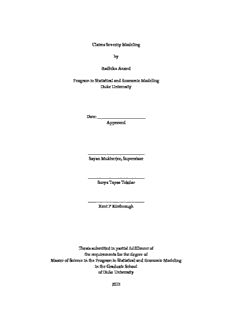Table Of ContentClaims Severity Modeling
by
Radhika Anand
Program in Statistical and Economic Modeling
Duke University
Date: _______________________
Approved
___________________________
Sayan Mukherjee, Supervisor
___________________________
Surya Tapas Tokdar
___________________________
Kent P Kimbrough
Thesis submitted in partial fulfillment of
the requirements for the degree of
Master of Science in the Program in Statistical and Economic Modeling
in the Graduate School
of Duke University
2015
ABSTRACT
Claims Severity Modeling
by
Radhika Anand
Program in Statistical and Economic Modeling
Duke University
Date: ________________________
Approved
_____________________________
Sayan Mukherjee, Supervisor
_____________________________
Surya Tapas Tokdar
_____________________________
Kent P Kimbrough
An abstract of a thesis submitted in partial
fulfillment of the requirements for the degree
of Master of Science in the Program in Statistical and Economic Modeling
in the Graduate School of
Duke University
2015
Copyright by
Radhika Anand
2015
Abstract
This study is presented as a portfolio of three projects, two of which were a part of my
summer internship at CNA Insurance, Chicago and one was a part of the course STA
663: Statistical Computation.
Project 1, Text Mining Software, aimed at building an efficient text mining software for
CNA Insurance, in the form of an R package, to mine sizable amounts of unstructured
claim notes data to prepare structured input for claims severity modeling. This software
decreased run-‐‑time 30 fold compared to the software used previously at CNA.
Project 2, Workers’ Compensation Panel Data Analysis, aimed at tracking workers’
compensation claims over time and pointing out variables that made a claim successful
in the long run. It involved creating a parsimonious Mixed Effects model on a panel
dataset of Workers’ Compensation claims at CNA Insurance.
Project 3, Infinite Latent Feature Models and the Indian Buffet Process (IBP), used IBP as
a prior in models for unsupervised learning by deriving and testing an infinite Gaussian
binary latent feature model. An image dataset was simulated (similar to Griffiths and
Ghahramani (2005) [1]) to test the model.
iv
Contents
Abstract ......................................................................................................................................... iv
List of Tables ............................................................................................................................... viii
List of Figures ................................................................................................................................ ix
Acknowledgements ....................................................................................................................... x
1
Text Mining Software ............................................................................................................... 1
1.1
Introduction .................................................................................................................... 1
1.1.1
Motivation ............................................................................................................ 2
1.1.2
Proposed Text Analytics Pipeline ..................................................................... 2
1.2
Software Functionality .................................................................................................. 4
1.3
Software Design, Methodology and Implementation .............................................. 5
1.4
Breakdown of Speed Improvements .......................................................................... 6
1.5
Final R Package: ‘cta’ ..................................................................................................... 7
1.6
Applications ................................................................................................................... 8
2
Workers’ Compensation Panel Data Analysis .................................................................... 9
2.1
Motivation ...................................................................................................................... 9
2.2
Dataset ............................................................................................................................. 9
2.3
Model Specifications ................................................................................................... 11
2.4
Initial Insights ............................................................................................................... 12
2.5
Next Steps ..................................................................................................................... 13
3
Infinite Latent Feature Models and Indian Buffet Process ............................................... 14
v
3.1
Background ................................................................................................................... 14
3.1.1
The Indian Buffet Process (IBP) ...................................................................... 14
3.1.2
Applications ..................................................................................................... 16
3.2
Implementation ............................................................................................................ 16
3.2.1
Infinite Linear-‐‑Gaussian Binary Latent Feature Model ............................. 17
3.2.2
Algorithm ......................................................................................................... 17
3.2.2.1
Likelihood ......................................................................................... 17
3.2.2.2
Gibbs Sampler .................................................................................. 17
3.2.2.3
Metropolis Hastings ........................................................................ 18
3.3
Profiling and Optimization ........................................................................................ 19
3.3.1
Optimizing Matrix Inverse .............................................................................. 20
3.3.2
Optimizing Likelihood Function and the Sampler ...................................... 20
3.3.3
Cythonizing ....................................................................................................... 22
3.4
High Performance Computing .................................................................................. 22
3.4.1
Multicore Programming .................................................................................. 22
3.4.2
GPU Programming ........................................................................................... 23
3.5
Application and Results .............................................................................................. 23
3.5.1
Data Simulation ................................................................................................ 23
3.5.2
Results ................................................................................................................ 25
3.5.2.1
Detection of total number of latent features ............................... 25
3.5.2.2
Detection of latent features present in each object and Object
Reconstruction .................................................................................................. 26
vi
3.5.2.3
Validation ........................................................................................ 28
3.6
Comparison .................................................................................................................. 28
3.6.1
Comparison with MATLAB Implementation .............................................. 28
3.6.2
Comparison with Chinese Restaurant Process ............................................ 29
3.7
Conclusion .................................................................................................................... 31
Appendix A .................................................................................................................................. 32
References ..................................................................................................................................... 33
vii
List of Tables
Table 1: Run-‐‑times and times speedup ...................................................................................... 6
Table 2: Runtimes for inverse functions (for 1000 loops) ...................................................... 20
Table 3: Runtimes for likelihood function (for 1000 loops) ................................................... 21
Table 4: Total runtimes ............................................................................................................... 21
Table 5: Presence/absence of latent features in the simulated data. 1 denotes presence, 0
denotes absence. F1, F2, F3, F4 refer to the 4 features in Figure 9 (in that order). ............. 28
viii
List of Figures
Figure 1: Proposed text analytics pipeline ................................................................................. 3
Figure 2: Text mining software functionality ............................................................................ 4
Figure 3: Software design, methodology and implementation .............................................. 6
Figure 4: Snapshot of R package: ‘cta’ ........................................................................................ 7
Figure 5: Panel data snapshot .................................................................................................... 11
Figure 6: Univariate statistics by triage group ........................................................................ 12
Figure 7: Variables that increase/decrease the odds of claim close ...................................... 13
Figure 8: Profiler results ............................................................................................................. 19
Figure 9: Features/basis images used to simulate data .......................................................... 24
Figure 10: Simulated data (first four of 100 images) .............................................................. 24
Figure 11: Trace plots for K, alpha, sigma X and sigma A .................................................... 26
Figure 12: Histograms. (a) Posterior of K (b) Features (ordered by frequency of
occurrence) .................................................................................................................................... 26
Figure 13: Features detected by code ........................................................................................ 27
Figure 14: Reconstructed images ............................................................................................... 27
Figure 15: Profiling results of MATLAB code for IBP ............................................................ 29
Figure 16: Chinese Restaurant Process ..................................................................................... 30
Figure 17: Indian Buffet Process ................................................................................................ 31
Figure 18: Sample hash process ................................................................................................. 32
ix
Acknowledgements
I extend a sincere thanks to my wonderful professors at Duke University and amazing
mentors at CNA Insurance, Chicago.
x
Description:Project 1, Text Mining Software, aimed at building an efficient text mining software for. CNA Insurance, in the form of an R package, to mine sizable amounts of unstructured claim notes data to compensation claims over time and pointing out variables that made a claim successful in the long run.

